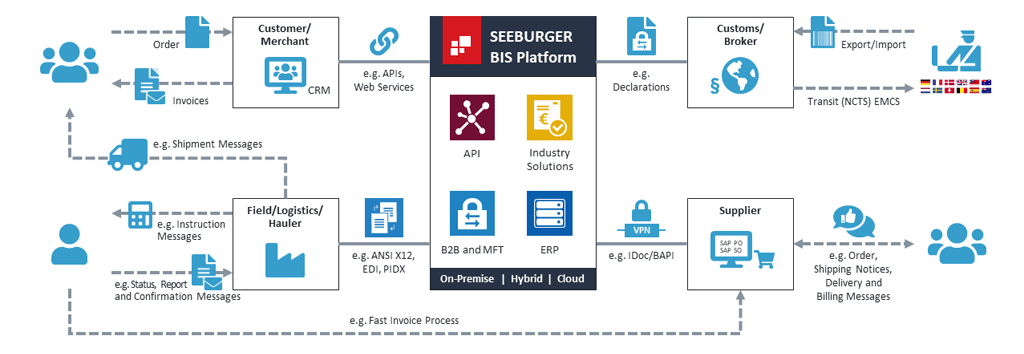Oil and Gas Industry 2021 Outlook: Reducing Costs and Speeding Time-to-Market

50 years ago, there were seven oil and gas companies in the top 20 of the Fortune 500 in the United States. Now there are only two. There are a number of reasons for this, including the rise of tech companies, the implosion of the price of oil in the 80’s and 2014, and more.
But the oil and gas industry still fuels the modern world, and the unique issue of the last few weeks – the interruption of the Colonial Pipeline – has refocused attention on this most critical of industries.
Gartner recently published a report on the “Top 10 Trends Driving the Oil and Gas Industry in 2021” (March 8, 2021, Rich McAvey, Simon Cushing). One of the key takeaways for us at SEEBURGER is, quoting:
“All oil and gas companies continue to struggle with nonintegrated data and substantial unresolved technology debt (aka, obsolete technologies and solutions). Consequently, operating costs are too high and change is too slow.”
This analysis reinforces why our work with the Petroleum Industry Standards Exchange (PIDX) is so important for the industry.
PIDX was created to specify and encourage data and process standards for the petroleum industry. In our view, standardization is key to integration, and is why SEEBURGER was created 35 years ago when we helped develop the first EDI specification for automotive integration in Germany.
PIDX is committed to developing standards for the entire industry – and its stated position is that they are not to be used to gain competitive advantage. Given the state of the industry as seen by Gartner noted above, it seems counterintuitive, but Oil and Gas companies that are using industry standards such as PIDX for integration are potentially gaining competitive advantage – over companies that are NOT using those standards.
In the recent PIDX International 2021 Virtual Spring Conference, Rob Ratchinsky, CEO of Engage, asked some provocative but critical questions in his presentation:
“How do we get rid of the invoice? Why does the invoice exist? …think about changing the way we are transacting, because we do it as consumers, why do we not do it in B2B?”
We believe it is this “out-of-the-box” type of thinking that will help modernize the Oil and Gas industry more quickly, as companies respond to both internal and external pressures to reduce costs and speed time-to-market. There are many opportunities like this one to use “leapfrog” strategies in integration, because in many cases companies are so far behind technologically, they can migrate to fully modern techniques without many of the stepwise tasks (and constraints) that might have been required if they had stayed current over the years.
Another speaker at the PIDX Spring event, Chris Lambert, CEO of Payload Technologies, discussed the never-ending conflict between utilizing a “single vendor” software approach (such as SAP), and using “best of breed” solutions that might deliver deeper functionality but for a narrower functional area. There were many pros and cons for each that he discussed. Lambert’s position was that taking the “single vendor” approach in order to avoid having to do integration is misguided:
“Key Takeaway: In either case [single vendor or best of breed], Integration is inevitable as your software ecosystem evolves.”
How SEEBURGER Helps Oil and Gas
From SEEBURGER’s perspective, that fight between “single vendor” and “best of breed” is not the most important thing – the ability to integrate to ANY system is. Our single, agile, secure and scalable integration platform is designed that way from the ground up.
In the oil and gas industry, we help companies reduce costs and speed time to market. Market forces are also pushing this industry to innovate, something it is not used to.

Mr. Ratchinsky, in the presentation cited above, spoke of a situation where there were 50 different invoicing formats for 50 different vendors to one of their clients. This is the type of challenge that SEEBURGER is ready-made for – we have dozens of connectors, pre-packaged integrations and predefined compliance checks – all supporting PIDX standards. And we back those up with an unparalleled consulting and support team.
To innovate and reduce costs, we help customers improve their onboarding processes by reducing (if not eliminating) manual steps and providing self-service capabilities for partner maintenance tasks. In oil and gas, this includes automation of onboarding for customers, suppliers, vendors, haulers and logistics partners. And if you need help with trading partners, our dedicated managed services team can handle all your partner connections.
Thank you for your message
We appreciate your interest in SEEBURGER
Get in contact with us:
Please enter details about your project in the message section so we can direct your inquiry to the right consultant.
Written by: Jan Kirsch
Jan Kirsch, SVP Utilities, Oil, Gas and Chemicals, is responsible globally for a whole industry vertical. Jan has more than 20 years’ experience working with energy and utility companies providing architectural advice and solutions for business integration and digital transformation. His areas of experience include IT architecture, Business Development and Consulting for EAI, Data Integration, Portals and B2B communication. Prior to working for SEEBURGER, he was in several consulting and management roles. In his spare time, Jan enjoys spending time with his family and is a huge fan of classic American muscle cars.





